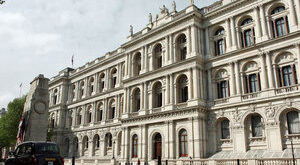The media we consume is not created solely to entertain. The minds behind the characters and tales we enjoy work to showcase a picture of the world they wish us to see. Superheroes are no exception.
We were first introduced to Captain America when he punched Hitler in the jaw on the cover of a 1941 comic book — nine months before the US would officially join World War II. His image was used throughout the decades to glorify US war efforts and animate the idea of American exceptionalism. While much has changed since the 1940s, Marvel’s superheroes remain dedicated to advertising the US’s military pursuits.
No less than six Marvel movies have been made with financial support from the US military — including Captain America (2011) and its sequel, Captain Marvel (2019), and Iron Man (2008), both 1 and 2. By subsidizing military hardware, allowing media conglomerates to film on military bases, and facilitating the recruitment of off duty soldiers as extras, the Pentagon validates the movie’s script, and weighs in to approve the final film with advanced viewings.
This seemingly fantastical connection between hawkish foreign policy and the blockbuster Marvel Cinematic Universe (MCU) is not make-believe. Pop culture has been militarized. Americans are often inundated with cultural projects such as movies, games, and TV shows that promote militarism, leading America’s cultural identity to become intertwined with the nation’s military interests.
*
Iron Man, a worldwide phenomenon and foundational character in the $31 billion MCU, amassed his fortune by manufacturing weapons for the US government. Between the big screen and the comic book, Iron Man’s character is always enmeshed within the defense industry, serving as the Secretary of Defense in one comic and head of SHIELD — what Pulitzer Prize-winning journalist turned Iron Man comic book writer Spencer Ackerman calls Marvel’s “America-centric intelligence agency” — in another.
In Marvel’s Iron Man (2008) — which received initial Pentagon assistance — Tony Stark grapples with the moral implications of the defense contractor gambit, nearly dying by one of his own Stark Industries missiles when visiting war-torn Afghanistan. Later renouncing his company’s arms contracts, Tony Stark uses his newfound Iron Man suit in an attempt to stop the further use of his weapons by terrorists. Later he defeats the son of his father’s old business partner who had turned to crime in an ill-fated effort to ensure Stark Industries continued to pump-out lucrative armaments.
In Ackerman’s latest comic release, “The Insurgent Iron Man,” Doctor Doom has crowned himself global emperor, using the people’s dissatisfaction with the status quo to prop himself up as a savior strongman. Iron Man, who has been fighting Stark Industries’ board of directors to stop his reclaimed company from manufacturing weapons, now wonders if the threat Doctor Doom poses supersedes his own moral dilemma.
To the shock of his board, Iron Man decides to return to the weapons game. He hopes to funnel weapons to a terrorist group that believes it can spur an uprising against Doctor Doom — quite a reversal from the 2008 Tony Stark. The legitimacy of war as a business remains a telling theme of the comic.
- The real-life business of war, coined the Military-Industrial Complex, was born in the early days of the Cold War. According to Miriam Pemberton, author and Associate Fellow at the Institute for Policy Studies, it began when the leaders of the United States decided that the temporary emergency work orders of WWII — which redirected vast swaths of America’s private production capacity towards weapons manufacturing — needed to become permanent and maintain the arms makers in perpetuity.
For such a system to endure indefinitely, the MIC needed friends in high places. Now, with more lobbyists than congressional members of the House, American weapons manufacturers spread their contracts across the American landscape. Pemberton called it a “political protection racket” that furthers what should “more accurately” be titled the Military-Industrial-Congressional Complex at a recent Costs of War event.
And through this racket, the United States’ MIC continues to expand its hegemony over the global arms trade. According to the Stockholm International Peace Research Institute (SIPRI) latest Fact Sheet, the US exported 43% of major global weapons between 2020 and 2024 — with the country’s share of the global arms exports increasing by 21% over the last decade.
Far from the often touted, WWII-era idea of America serving as the “arsenal of Democracy,” 75% of countries considered to be Not Free by Freedom House receive “defense articles or services, either by the US government or an American commercial vendor to a foreign client.” And the public has serious qualms about US arms sales, with 70% agreeing that these exports make America less safe, according to a 2019 poll by the Chicago Council on Global Affairs. These attitudes shifted in the early days of US exports to Ukraine to defend itself against the Russian invasion of their country, and were again altered by widespread opposition to providing arms to Israel that were used in its campaign of mass slaughter in Gaza.
The antipathy towards arms sales does not extend to the men and women of the US armed forces. According to Pew research, most Americans hold a positive view of the military. That may be partially due to the media they consume. From Top Gun (1986) and the Call of Duty video games, to GI Joe, America is chock-full of militarized media. According to Josue Scian, a Dissenters field organizer, who also spoke at the Costs of War event, this media helps glorify war and manufacture the public consent necessary for the MIC to flourish. Messaging embedded in popular culture helps align American pride and collective identity with the further expansion of the nearly $850 billion defense budget.
Scian described how through the repeated display of an implied, foreign and unquantifiable evil that someone needs to do something about — such as in Marvel’s Avengers (2012), in which the Avengers unite to save Earth from an alien army eager to enslave humanity — media conglomerates, with the Pentagon’s cash in tow, weaponize fear of the “other” to advertise the further militarization of US foreign policy.
*
In some Iron Man renditions, Stark Industries moves away from serving as a “Lockheed Martin-type” defense contractor to become the premier technology company on Earth, hawking new green technology innovations and autonomous software capabilities, including those used for surveillance. Believing himself to be free of the moral ambiguities that plague weapons production, Iron Man is then faced with the reality that “the best weapons don’t shoot,” as Ackerman wrote, “they target the foundations of freedom.”
No less than six Marvel movies have been made with financial support from the US military.
According to political anthropologist David Vine, “the militarization of pop culture is broad.” It spreads far beyond the silver screen. Hyper-militarism is prevalent in many different forms of media, including ubiquitous social media posts that seek to normalize militarism in day-to-day life. This bleeds into the militarization of police departments as they continue to utilize military weaponry and surveillance technology to act more violently, censor the public and weaken civil rights. While advertised for children, set in alternate realities, and obviously not real, popular media and entertainment — including superheroes — are intrinsically linked to our perception of reality and often directly influence our security state. One of the civilian-clothed Department of Homeland Security officers who abducted Mahmoud Khalil after he participated in non-violent pro-Palestinian protests at Columbia University, for example, was wearing a Marvel Comics t-shirt.
Politics and pop culture reside in the same cinematic universe. Separating a seemingly benign comic decal worn by a US immigration officer as he arrested a lawful US resident in a case that threatens the constitutional right to free speech would downplay the true power that entertaining media has over the American psyche. The media we consume is made to charm us, but its ulterior motives must always be questioned, particularly when it’s being manufactured in close cooperation with the security state.
 Eurasia Press & News
Eurasia Press & News



